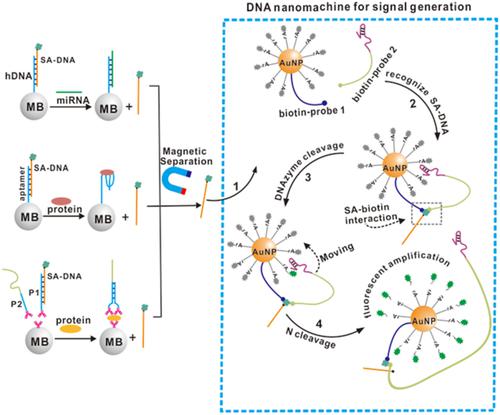当前位置:
X-MOL 学术
›
Luminescence
›
论文详情
Our official English website, www.x-mol.net, welcomes your
feedback! (Note: you will need to create a separate account there.)
A signal conversion system using binding-induced strand displacement for disease biomarker assay
Luminescence ( IF 3.2 ) Pub Date : 2021-05-19 , DOI: 10.1002/bio.4087 Yuling Jiang 1 , Peng Yang 2 , Lijie Du 2 , Lingying Xia 2 , Junbo Chen 2 , Xiandeng Hou 1, 2
Luminescence ( IF 3.2 ) Pub Date : 2021-05-19 , DOI: 10.1002/bio.4087 Yuling Jiang 1 , Peng Yang 2 , Lijie Du 2 , Lingying Xia 2 , Junbo Chen 2 , Xiandeng Hou 1, 2
Affiliation

|
Using the principle of binding-induced DNA strand displacement (BINSD), a DNAzyme-powered nanomachine biosensor for multiple biomarkers via magnetic beads-based signal conversion was designed. This sensor can convert multiple biomarker recognition into release of predesigned output nucleic acids tagged with streptavidin proteins (SA-DNA) for activation of DNA nanomachines. In general, we adopted complementary base pairing rules and affinity ligand specific recognition, and three types of signal conversion systems were constructed that realized universal, sensitive, accurate, and specific detection of multiple biomarkers. Taking the advantage of the strong anti-interference capability of magnetic separation, this strategy could be used for detection of various biomarkers in clinical practice.
中文翻译:

使用结合诱导链置换进行疾病生物标志物检测的信号转换系统
利用结合诱导 DNA 链置换 (BINSD) 的原理,设计了一种 DNAzyme 驱动的纳米机器生物传感器,通过基于磁珠的信号转换来检测多种生物标志物。该传感器可以将多种生物标志物识别转化为预先设计的带有链霉亲和素蛋白 (SA-DNA) 标记的输出核酸的释放,以激活 DNA 纳米机器。总的来说,我们采用互补碱基配对规则和亲和配体特异性识别,构建了三种类型的信号转换系统,实现了多种生物标志物的通用、灵敏、准确和特异性检测。利用磁分离强大的抗干扰能力,该策略可用于临床实践中各种生物标志物的检测。
更新日期:2021-05-19
中文翻译:

使用结合诱导链置换进行疾病生物标志物检测的信号转换系统
利用结合诱导 DNA 链置换 (BINSD) 的原理,设计了一种 DNAzyme 驱动的纳米机器生物传感器,通过基于磁珠的信号转换来检测多种生物标志物。该传感器可以将多种生物标志物识别转化为预先设计的带有链霉亲和素蛋白 (SA-DNA) 标记的输出核酸的释放,以激活 DNA 纳米机器。总的来说,我们采用互补碱基配对规则和亲和配体特异性识别,构建了三种类型的信号转换系统,实现了多种生物标志物的通用、灵敏、准确和特异性检测。利用磁分离强大的抗干扰能力,该策略可用于临床实践中各种生物标志物的检测。











































 京公网安备 11010802027423号
京公网安备 11010802027423号